Abstract
Although the application of laser wireless energy transmission technology in many fields such as UAV power supply is increasing, the laser incidence angle and beam shift remain the key factors limiting the efficiency of long-range laser wireless energy transmission. In this study, a laser cell response test platform was built to measure and analyze the response characteristics of a laser cell under different laser incidence angles and beam shifts. The results show that the increase in the incident angle intensifies the reflection on the irradiated surface, resulting in a linear decrease in the power density received by the laser cell, which eventually leads to a significant decrease in the output power, and the output power tends to be close to 0 when the incident angle exceeds 75°. The increase in the beam offset distance increases the reverse bias of the cell, which is the main reason for the significant decrease in the output power. The local irradiation also leads to an increase in the heat generation power; when the beam coverage is below 50%, the overall output power tends to be close to 0. This study provides a reference for improving the laser wireless energy transmission efficiency and laser cell optimization.
1. Introduction
Wireless power transmission technology refers to a brand-new mode of power supply, whereby power can be transmitted without cables. Using lasers and microwaves as vectors, long-distance wireless power transmission technology can be applied to terrestrial power distribution systems, space energy utilization, unmanned networking, and unmanned clusters. Wireless transfer of power between subsystems and ”unlimited” power supply for weapons equipment can be achieved in principle. Laser wireless power transmission (LWPT) is an energy supply system [1] that uses a laser as an energy transmission carrier to provide energy support to a target device operating in a specific environment without relying on energy transmission lines. LWPT is mainly composed of a laser transmitting system, laser receiving system, energy management system, and load [2]. The laser transmitting system is composed of power supply, laser driver, laser, laser emission system, tracking and aiming system, etc. The laser receiving system is composed of laser battery, heat dissipation system and so on. Energy management system includes maximum power point tracker, energy storage batterie and energy monitoring system. In the laser-based wireless power transmission process, the electrical energy in a power grid or energy storage unit is converted by a laser power source and is provided to a laser. The laser converts the electrical energy into a laser beam, which is captured by a photovoltaic array. The laser output is converted into electrical energy at the receiving end after free-space transmission.
LWPT is a current research hotspot because it is highly directional and energy-focused compared to traditional energy transfer methods, and can be powered at a distance with a smaller transmit power. In recent years, owing to its advantages of long transmission distance, high power density, and high conversion efficiency without dependence on energy transmission lines, laser-based energy transmission can be used for ground electric energy distribution, spatial scientific research, spatial energy utilization, and concealed spatial communications. LWPT provides energy for mobile electric equipment such as mobile base stations, unmanned aerial vehicles (UAVs) energy supplies, airships, robots, deep-space probes, and module spacecraft, and it has potential applications in many fields such as sea, land and air. In September 2003, at the NASA Marshall Space Flight Center [3], engineers manually directed the laser energy beam from the central platform to the infrared-sensing laser battery on the bottom panel of the light model aircraft using only the laser energy to power the aircraft to achieve flight, as shown in Figure 1. The proposed “aircraft flying indefinitely” is a concept that has potential application in research by the scientific community, as well as in the remote sensing and telecommunications industries. Laser wireless energy transmission technology involves laser structure design, transmission efficiency of high power laser in the atmosphere, photoelectric conversion efficiency of photovoltaic cells under monochromatic laser radiation. At present, based on the traditional optical design and laser applications, many researchers have carried out theoretical research and experimental measurement on high-power lasers, Gaussian beam shaping, and photoelectric conversion efficiency of photocells.
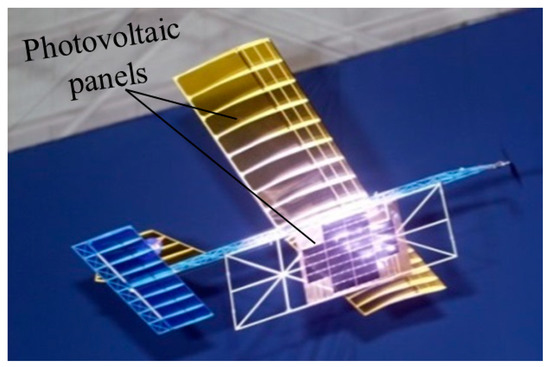
Figure 1.
Aircraft radio-fed flight.
In 2007, Nobuki Kawashima et al. [4] conducted a wireless energy-transfer experiment using a laser on an electric kite, as shown in Figure 2. A semiconductor laser with a wavelength of 808 nm and power of 200 W was used, and a 30.4 cm × 7 cm GaAs photovoltaic device was connected in series and parallel and mounted on the electric kite as a receiver. The electric kite hovered at an altitude of 50 m with a diameter of 10 m for an hour and landed safely; the average output power was measured to be 40 W. In 2011, Marcus Smith et al. [5] conducted outdoor LWPT experiments. The experimental wavelength of the laser and the choice of the laser cell material were based on experiments conducted by Brandhorst et al. [6] in 2003. The experiments used a laser with a power of 2.5 kW and a wavelength of 810 nm, and 40 GaAs solar cells were used as receivers, which were placed at a distance of 100 m from the laser. The low reception power was due to the poor quality of the laser beam irradiated onto the panel and the failure to cover the solar panel in full. This outdoor experiment is an important reference for the engineering design of a laser wireless energy transmission system and for the specific operation of the experiment. In 2012, Lockheed Martin and Laser Motive collaborated to successfully increase the airborne endurance of the stalker UAV from 2 h to more than 48 h [7] using laser energy supply methods. This experiment also enables energy transfer to multiple UAVs hovering near a single-laser launch base. This experiment plays an important role in the application of military and civilian long-endurance UAVs.
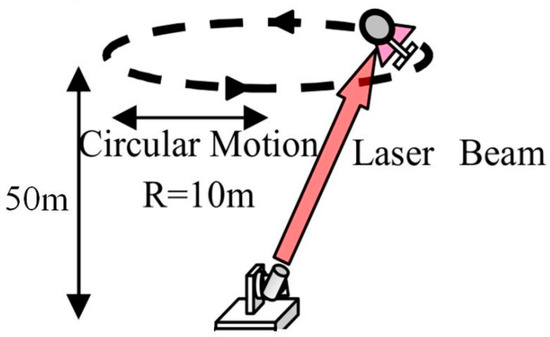
Figure 2.
Electric kite wireless energy transmission experiment.
The response characteristics of the laser cell are the key factors affecting the transmission efficiency of the system, and scholars from various countries have conducted extensive research on this topic. In 2010, the U.S. Naval Laboratory [8] analyzed the effect of different laser power densities on the response characteristics of GaAs solar cells under the irradiation of a three-wavelength laser system with wavelengths varying around 555, 860, and 1510 nm. As shown in Figure 3, the calculated photoelectric conversion efficiency was 51.15% under laser irradiation at an output power density of 0.049 W/cm2, which is a considerable improvement from 36.29% under sunlight irradiation.

Figure 3.
Conversion efficiency of laser cells with different materials versus wavelength.
Erdem et al. [9] studied the effects of solar power density and silicon cell temperature on cell output in 2013, and the experimental results showed that the best way to improve the performance of laser cells is to reduce the laser cell temperature and increase the incident optical power on the surface of the laser cells, which has some reference value for the study of the characteristics of laser cells under laser irradiation. In 2014, Qiao Liang et al. [10] from the Nanjing University of Aeronautics and Astronautics studied the effect of laser power density on the energy-conversion efficiency of GaAs photovoltaic cells. GaAs cells with different laser power densities irradiated 2 m away were used, and the photoelectric conversion efficiency of GaAs cells showed a single-peak characteristic with the variation in laser power density. In 2016, Liu et al. [11] conducted a theoretical analysis and experimental study of the response characteristics of photovoltaic devices under inhomogeneous laser irradiation, and the results showed that the parallel photovoltaic devices were less affected by the distributed inhomogeneous laser irradiation, and the photoelectric conversion efficiency decreased linearly with the increase in temperature; therefore, the optimization of photovoltaic cells is needed to control the temperature.
In recent years, against the background of an increasing demand for the battery life capability of UAVs, domestic research institutes such as Nanjing University of Aeronautics and Astronautics, Wuhan University, Shandong Institute of Aerospace Electronics Technology, the 18th Institute of China Electronics Science and Technology Corporation have vigorously carried out research on laser energy supply mechanisms, moving target tracking, etc. [12,13,14,15,16]. The above units are also committed to the research of laser energy transfer target tracking technology, first using altitude, GPS, machine vision, and other methods of initial alignment, and then combined with accurate laser alignment. In regards to laser reception and conversion, photovoltaic cells are used to convert the received laser energy into electricity. At the same time, power management is considered. For example, in addition to the maximum power point tracking and charging technology, some researchers add optical signal acquisition and conversion circuit at the receiving end, which can realize the simultaneous transmission of signal and energy [17,18].
However, the laser cell deteriorates and thus the actual energy conversion efficiency of the energy transfer system is reduced. Therefore, it is important to study the voltammetric characteristics of the laser cell under different laser irradiation conditions to improve the theoretical application of a laser wireless energy transfer system. During the flight of the UAV, the laser cell fixed on the target device will form an angle with the ground energy supply device as the flying position of the device changes. Furthermore, there are errors in the response speed and tracking accuracy of the ground tracking device of the system. This together results in the phenomenon of the oblique incidence of the light spot and partial irradiation of the light spot (as shown in the Figure 4), which causes the response characteristics of the wireless energy transfer efficiency and provides basic data support for subsequent laser wireless energy transfer applications.
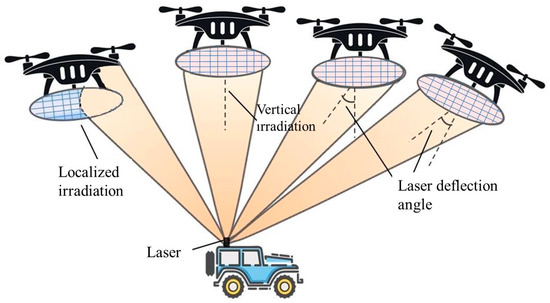
Figure 4.
Schematic diagram of laser incidence.
To address the problem of the low energy conversion efficiency of existing laser cells with high irradiance, this paper designs and builds a laser cell response test platform, simulates the possible non-vertical laser incidence under different laser irradiation conditions, tests the response characteristics and system energy conversion efficiency of laser cells when irradiated with different incidence angles and different beam coverage, and analyzes the experimental results.
2. Experimental Method
2.1. Experimental Setup
The experimental setup consisted of a transmitting system, receiving device, and load; the platform composition is shown in Figure 5. During the experiment, the laser incidence angle and the area of the beam covering the cell plate were changed to test the response characteristics of the laser cell under different irradiation conditions.
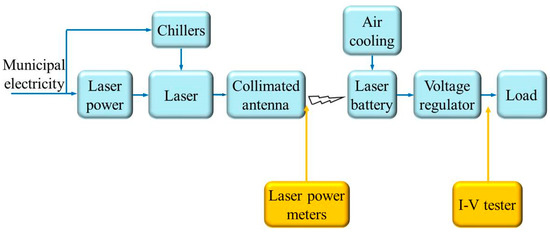
Figure 5.
Experimental platform composition.
As can be seen from Figure 3, the GaAs battery is able to have a higher conversion efficiency under 808 nm laser irradiation. Additionally, continuous lasers are better at transmitting energy over long distances than pulses of light. Therefore, a semiconductor laser with an output laser wavelength of 808 nm was selected for the transmitter system, which had a continuously adjustable output power and emitted the laser through an optical fiber. The laser power was measured using a laser power meter. The receiving device was a circular multijunction GaAs cell with a diameter of 10 cm. The system consisted of an angle-adjustable rotary displacement stage to meet the needs of different laser incidence angles, and a horizontal displacement stage to meet the needs of beam deflection. The laser spot arriving at the laser cell matches the size of the cell plate, and the spot is observed using an infrared viewer. The load was connected to an I–V tester to measure the maximum current (Im), maximum voltage (Um), and maximum output power (Pm) of the laser cell under laser irradiation.
The physical laser cell is shown in Figure 6.
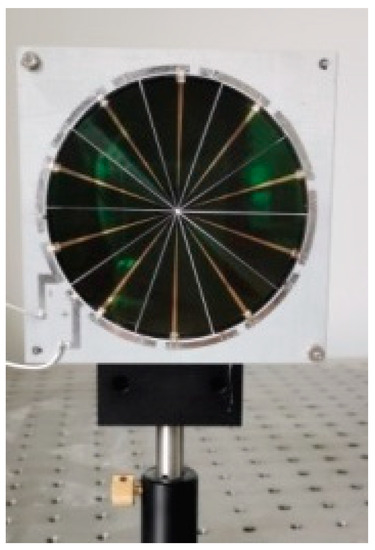
Figure 6.
Laser cell.
2.2. Experimental Conditions and Steps
The distance between the laser and the laser cell was 20 cm; the laser was irradiated vertically onto the laser cell at 0° incidence by default in the experiment, and a circular multi-junction GaAs cell with a diameter of 10 cm was irradiated at different incidence angles. The beam shift distance was changed sequentially in the beam shift experiment, and the shift range was 0–60 mm, corresponding to the beam coverage rate, which was calculated as the actual received laser area of the cell/laser cell area. According to the beam coverage formula and the laser cell area calculation, the beam coverage corresponding to 0 mm–60 mm offset is 100%, 93.63%, 87.29%, 80.97%, 74.71%, 68.5%, 62.38%, 56.36%, 50.46%, 44.7%, 39.1%, 31.66%, and 25.22%. The laser wireless energy transfer efficiency was measured as follows.
The laser output power was adjusted so as to have a stable output of 15 W irradiating the laser cell, the rotary displacement table was adjusted at the receiving end, and the rotation angle was changed. When the vertical incident laser spot at the laser cell coincided with the size of the cell plate, the I–V curve at the output of the laser cell was measured using the I–V tester, and the response characteristics of the laser cell to the laser and the system output power under different laser incidence angles were recorded. A schematic of the angular test is shown in Figure 7.
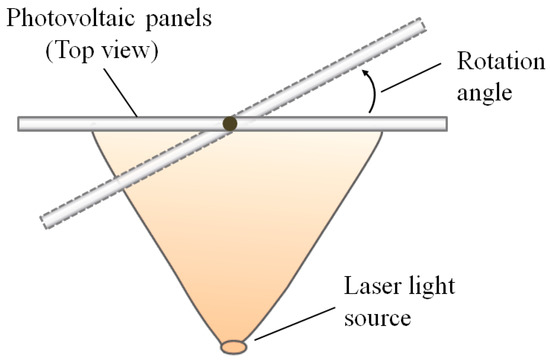
Figure 7.
Schematic of laser incidence angle test.
Next, the laser output power was changed to maintain a stable output of 10 W irradiating the laser cell vertically. By moving the laser cell plate and changing the beam offset distance, the beam coverage was adjusted to 100%, 93.63%, 87.29%, 80.97%, 74.71%, 68.5%, 62.38%, 56.36%, 50.46%, 44.7%, 39.1%, 31.66%, and 25.22%. Beam coverage = beam coverage area/laser cell plate area. The I–V curve at the output of the laser cell was measured using an I–V tester to record the response characteristics of the laser cell to the laser and the energy-conversion efficiency of the system under different beam coverage conditions. The beam shift experiment is illustrated in Figure 8.
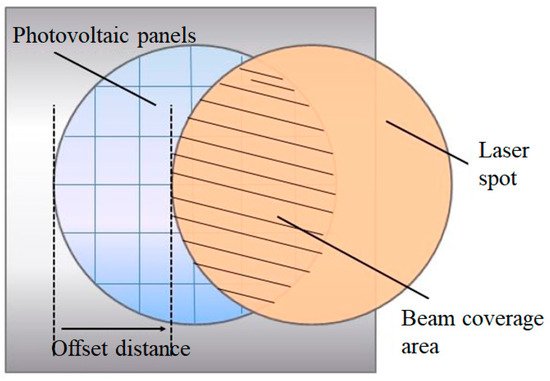
Figure 8.
Laser beam deflection diagram.
3. Experimental Results and Analysis
3.1. Effect of Laser Incidence Angle on Response Characteristics and Conversion Efficiency of Laser Cells
The relationship curves between the laser incidence angle, laser cell response characteristics, and system output power were obtained from the experimental data.
As can be seen from Figure 9, with an increase in the laser incidence angle, the maximum current decreased significantly and almost dropped to 0 after 75°. The maximum voltage first remained stable and then decreased sharply after the rotation angle exceeded 75°. This is due to the different degrees of laser reflection [19] under the different angles of laser incidence, which makes the light intensity of each cell component different and produces different photogenerated currents and output voltages, making it possible for some of the bypass diodes connected in parallel at both ends of the component to work in the ON state, resulting in changes in the output characteristics of the series-connected component. When the incident angle is small, the laser cell receives laser light more uniformly, the short-circuit current is larger, and the reverse bias voltage of the cell in the slightly weaker laser irradiation area is smaller, which reduces power consumption. As the incident laser angle increases, the short-circuit current of the battery in the weaker laser irradiation area decreases, but the reverse bias voltage increases significantly. Thus, the power consumption increases, the output voltage drops sharply, and the output power decreases.
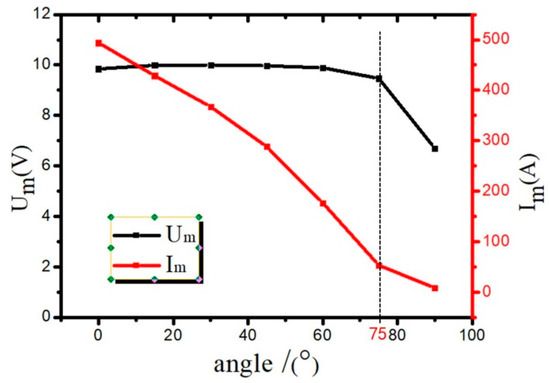
Figure 9.
Waveforms of maximum current and maximum voltage with incident laser angle.
According to the changing trend in Figure 9, the changing incident parameter is set as the laser incident angle, and the laser power density is set as a constant incident parameter, whose magnitude is in accordance with equation,
where Gθ is the laser power density received on the laser cell when the rotation angle is θ° and Go is the laser power density received on the laser cell when the rotation angle is 0°, that is, vertical incidence. Therefore, when the rotation angle increases, the laser power density received on the laser cell decreases, and a cosine correlation exists between them [20]. When the laser incidence rotation angle was larger, the maximum current and maximum voltage of the laser cell were reduced, and the system output power was reduced.
Gθ = Go × cosθ
From the above equation, it is clear that the effects of non-vertical laser incidence and cosine reduction of the incident laser power density on the laser cell output are similar. To further increase the output power, it is necessary to increase the incident laser power density; however, a large laser power density will cause a significant temperature rise in the laser cell, causing a thermal resistance effect and compound current increase, which eventually leads to a significant decrease in the energy conversion efficiency of the laser cell. Therefore, to improve the energy conversion efficiency of the laser cell, it is necessary that the thermal resistance effect and compound current of the laser cell under laser irradiation be as small as possible, and at the same time, the temperature of the laser cell needs to be controlled by an efficient cooling system. Because increasing the incidence angle is equivalent to reducing the laser power density, when the incident laser power density is determined, positive incidence should be maintained as much as possible, or the angle should be controlled within 75°.
3.2. Effect of Beam Shift on the Response Characteristics and Conversion Efficiency of Laser Cell
The output characteristics of the system under different beam offset distances and system output power are tested experimentally.
The curves of the maximum current and voltage output of the laser cell with laser-beam coverage are shown in Figure 10. The maximum current of the laser cell decreased with a decrease in the laser beam coverage and almost dropped to 0 when the beam coverage was below 50%. This is because when the laser beam coverage is large, the light received on the laser cell is more uniform, but when the beam coverage decreases, the light received on the laser cell is partially reduced, the beam becomes more uneven, and the photogenerated carriers decrease, thus decreasing the photogenerated current, which finally decreases the maximum current. The maximum voltage first remained stable within a certain range as the laser beam coverage decreased and then dropped sharply when the beam coverage was below 32%. This is because when the beam coverage is relatively large, the short-circuit current is relatively large, and the reverse bias voltage of the battery at the edge is relatively small, which makes the power consumption relatively small. As the beam coverage decreases, the short-circuit current of the battery not receiving laser irradiation at the edge decreases, but the reverse bias voltage increases significantly, resulting in a sharp drop [21] in the maximum output voltage.
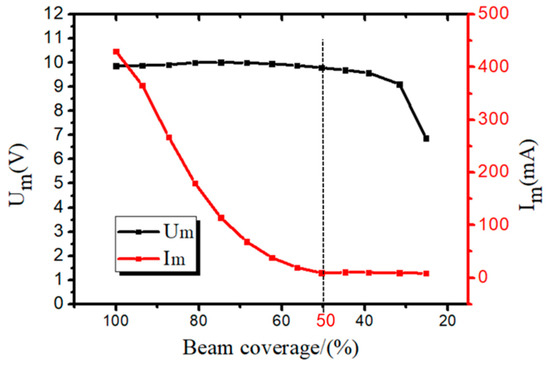
Figure 10.
Waveforms of maximum current and maximum voltage with incident beam coverage.
As shown in Figure 11, as the beam offset distance increased, the laser coverage power on the panel decreased linearly, the output power first decreased rapidly and then slowly decreased to zero, the heat generation power increased, and the heat flow density increased rapidly. It can be seen that the electrical power output was bad in the case of beam offset, and the overall energy conversion efficiency was reduced.

Figure 11.
Waveform Graph. (a) Trend of output power and thermal power with beam shift distance. (b) Trend of thermal power and heat flow density with beam shift distance.
The thermal power (i.e., power consumption) is the difference between the covered power and the output electrical power. In fact, the laser battery thermal power includes a portion of the laser energy that is absorbed by the battery as heat and the battery by the laser irradiation of the weaker part of the heating power of the two parts. The increase in battery temperature in the weaker part of the laser irradiation can be attributed to both the power consumed by the battery and the conversion into heat during the irradiation [22]. With the increase of beam deviation and incidence angle, the uneven illumination leads to local heating and the temperature rise of the battery, which further reduces the conversion efficiency of the battery.
High heating power can cause irreversible damage to the cell, especially in the case of local irradiation, because the heating power of the stronger part of the laser irradiation is much higher than that of the weaker part, and the heating power per unit area will be larger [23]. Therefore, when designing PV modules, the maximum heating power of the cells connected in parallel with the bypass diode should be considered simultaneously to meet the battery safety requirements [24,25].
4. Discussion and Conclusions
The overall energy conversion efficiency of the LWPT technology system is low and still requires technical breakthroughs in many aspects. However, with the development of laser and laser cell research, feasibility has greatly improved, and the technology has a wide range of application prospects. Current research in this area is being conducted in the direction of high transmission power, high transmission efficiency, and long transmission distance. Achieving high transmission efficiency is the main focus. In this study, the following conclusions were obtained from the experimental analysis.
1. The incident laser angle significantly affected the response characteristics and energy conversion efficiency of the laser cell under laser irradiation. When the laser incidence angle is larger, the maximum current and voltage of the laser cell are reduced, and the energy conversion efficiency is lowered, which is consistent with the changing trend of the response characteristics and energy conversion efficiency of the laser cell when the laser power density is reduced under positive incidence. Therefore, the output power of the laser cell at a large incidence angle is extremely small, and the high energy conversion efficiency has no practical application value. In the process of energy transfer, we considered controlling the incidence angle shift within 75°. Reducing the temperature rise effect when the power density increases is the key to improving the overall efficiency.
2. Beam coverage significantly affects the laser cell response characteristics and energy conversion efficiency under laser irradiation. As the incident laser beam coverage decreases, the system output power decreases. The trend of increasing power consumption is obvious. Thus, efforts should be made to avoid local irradiation and optimize cell heating power so that it is within the safe range during the PV module design.
This study can provide a basis for the selection of parameters for future applications of laser energy transmission technology. To obtain high laser cell output power and energy conversion efficiency, it is necessary to adopt more effective means to control laser tracking during long-distance transmission to ensure that the laser beam coverage is higher than 50%. When the incident laser power density is determined, positive incidence should be maintained as much as possible, and special structures should be prepared on the laser cell surface to reduce the reflectivity at a certain wavelength and increase the utilization of laser light energy.
Author Contributions
Research status, W.X. and X.W.; experimental scheme, C.X., J.C. and W.X.; Operation of experiment, S.L.; resources, J.C.; data curation, W.X.; writing—original draft preparation, S.L.; writing—introduction, W.X.; visualization, X.W.; Conclusion, C.X.; project administration, J.C. All authors have read and agreed to the published version of the manuscript.
Funding
This research received no external funding.
Institutional Review Board Statement
Not applicable.
Informed Consent Statement
Not applicable.
Data Availability Statement
Not applicable.
Acknowledgments
All the authors thank the experimental funding and guidance provided by the first author, all the reviewers for their reviewing and their valuable suggestions.
Conflicts of Interest
The authors declare no conflict of interest.
Abbreviations
The following abbreviations are used in this manuscript:
| Nomenclature | Meaning |
| LWPT | Laser wireless power transmission |
| UAV | Unmanned aerial vehicles |
| GaAs | Gallium arsenide |
| GPS | Global positioning system |
| Im | maximum output current of the laser cell under laser irradiation |
| Um | Maximum output voltage of the laser cell under laser irradiation |
| Pm | maximum output power of the laser cell under laser irradiation |
| Gθ | the laser power density received on the laser cell when the rotation angle is θ° |
| Go | the laser power density received on the laser cell when the rotation angle is 0° |
References
- Glaser, P.E. Power from the sun: Its future. Science 1968, 162, 857–861. [Google Scholar] [CrossRef] [PubMed]
- Wei, L.; Lingyuan, W.; Weiping, W. Research Progress of Laser Wireless Power Transmission. Adv. Lasers Optoelectron. 2018, 55, 020008. [Google Scholar] [CrossRef]
- Past Projects: Beamed Power Research. Available online: http://www.nasa.gov/centers/dryden/history/pastprojects/beam/index.html (accessed on 13 August 2009).
- Takeda, K.; Kawashima, N.; Yabe, K. Laser energy transmission to a small-unmanned aerial vehicle. Space Technol. 2008, 7, 27–32. [Google Scholar]
- Smith, M.; Tillotson, B.; Oliver, J. Development of a laser power beaming experiment. In Proceedings of the IEEE 2012 IEEE 38th Photovoltaic Specialists Conference (PVSC), Asutin, TX, USA, 3 June 2012; pp. 002825–002830. [Google Scholar]
- Brandhorst, H.W. Effects of the atmosphere on laser transmission to GaAs solar cells. In Proceedings of the 54th International Astronautical Congress of the International Astronautical Federation, the International Academy of Astronautics, and the International Institute of Space Law, Bremen, Germany, 29 September 2003. [Google Scholar]
- LMA Company. Lockheed Martin Performs First Ever Outdoor Flight Test of Laser Powered UAS. Science 2012, 162, 857–861. [Google Scholar]
- VanDyke, J.E. Modeling laser effects on multi-junction solar cells using Silvaco ATLAS software for spacecraft power beaming applications. Ph.D. Thesis, Monterey Naval Postgraduate School, Monterey, CA, USA, 2010. [Google Scholar]
- Cuce, E.; Cuce, P.M.; Bali, T. An experimental analysis of illumination intensity and temperature dependency of photovoltaic cell parameters. Appl. Energy 2013, 111, 374–384. [Google Scholar] [CrossRef]
- Liang, Q.; Yannan, Y. Experimental research of laser wireless power transmission efficiency. Laser Technol. 2014, 5, 590–594. [Google Scholar]
- Xiaoguang, L.; Wenshen, H.; Xun, L. Methods to improve efficiency of photovoltaic receiver for laser powered unmanned aerial vehicle. Infrared Laser Eng. 2016, 45, 5. [Google Scholar]
- Liegang, D.; Wenfeng, L.; Yannan, Y. High-precision aiming system for laser charging based on binocular machine vision. Laser Optoelectron. Prog. 2021, 58, 432–438. [Google Scholar]
- Zhenlei, S.; Wenwen, M.; Jingshi, S. Tracking design of APT system of laser wireless energy transmission for unmanned aerial vehicle. Laser Technol. 2019, 43, 809–814. [Google Scholar]
- Jianhua, Y.; Kai, H.; Husheng, H. Optimal tracking algorithm for laser powered unmanned aerial vehicles. J. Appl. Opt. 2020, 41, 194–201. [Google Scholar] [CrossRef]
- Wang, N.; Fei, D.; Jun, Z. Research progress on electronic energy wireless transfer and energy interconnection. Chin. J. Power Sources 2019, 43, 357–360. [Google Scholar]
- Zhipeng, L.; Yange, Z.; Yong, A. Laser tracking and wireless power supply system for unmanned aerial vehicles. Laser Technol. 2018, 42, 306–310. [Google Scholar]
- Zihao, C.; Wenshen, H.; Gang, L. Research of laser wireless power transmission for unmanned aerial vehicles and its tracking pointing methods. Laser Infrared 2018, 48, 275–279. [Google Scholar]
- Jiancheng, T.; Bingxu, Z.; Junjie, X. Design and implementation of laser charging system based on FPGA and machine vision. Electron. Des. Eng. 2019, 27, 189–193. [Google Scholar]
- Zheng, X. Theoretical Analysis of Antireflection Structure of Photovoltaic Cell Based on the Solar Spectrum. Master’s Thesis, Hebei University of Technology, Tianjin, China, 2014. [Google Scholar]
- Wei, L.; Lingyuan, W.; Weiping, W.; Jialei, Z.; Guodong, L.; Dayong, Z. Power conversion efficiency of photovoltaic cells in semiconductor laser wireless power transmission. Intense Lasers Part. Beams 2018, 11, 170–176. [Google Scholar]
- Yunyun, W. Effects of Nonuniform Temperature and Irradiance on the Photovoltaic Performance of a PV/T System. Ph.D. Thesis, University of Science and Technology of China, Hefei, China, 2015. [Google Scholar]
- Fengcai, L. Analysis of hot spot on the photovoltaic/thermal technology. Master’s Thesis, University of Science and Technology of China, Hefei, China, 2015. [Google Scholar]
- Dongdong, Q.; Rui, W.; Xiangai, C. Damage effect of monocrystalline silicon solar cells under ultrashort pulse laser irradiations. Infrared Laser Eng. 2012, 41, 112–115. [Google Scholar]
- Dianhong, L. Research on Concentrating Photovoltaic-Thermoelectric Hybrid Method and System Performance. Ph.D. Thesis, Nanjing University of Science and Technology, Nanjing, China, 2021. [Google Scholar]
- Ershuai, Y. Investigations on Principle and Optimal Design Method of a Photovoltaic-Thermoelectric Hybrid System. Ph.D. Thesis, Nanjing University of Science and Technology, Nanjing, China, 2019. [Google Scholar]
Disclaimer/Publisher’s Note: The statements, opinions and data contained in all publications are solely those of the individual author(s) and contributor(s) and not of MDPI and/or the editor(s). MDPI and/or the editor(s) disclaim responsibility for any injury to people or property resulting from any ideas, methods, instructions or products referred to in the content. |
© 2023 by the authors. Licensee MDPI, Basel, Switzerland. This article is an open access article distributed under the terms and conditions of the Creative Commons Attribution (CC BY) license (https://creativecommons.org/licenses/by/4.0/).